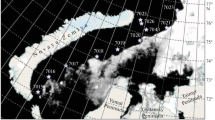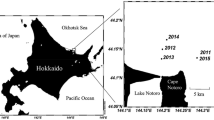Abstract:
Accounting for variability in oceanic primary production, which is generally attributed to physical forcing, requires a more integrated understanding through the quantification of biological parameters, such as phytoplankton cell size and physiology. An evaluation of predictions from allometric theory, where phytoplankton cell size should be inversely related to chlorophyll a specific primary production (mg C mg Chl a -1 h-1), was conducted using cruise data collected within 200 km of the coast in the upwelling zone off Coquimbo, Chile (30°S) during July 1995, January and July 1996. Discrete water samples at the surface and up to 6 depth strata, selected according to light extinction coefficients, were size-fractioned ± 8 μm for chlorophyll a (B) and primary production (P) measurements.¶Overall, specific primary production (PB) of the <8 μm fraction was significantly higher than PB of the >8 μm fraction (4.48 versus 2.88 mg C mg Chl a -1 h-1, P = 0.006 Wilcoxon test). Analysis of separate cruises indicated that during the July 1995 cruise, the negative relationship between phytoplankton size and PB was not obtained. This result suggests that at smaller scales, the phytoplankton size versus PB relationship could change according to an increase in the acquisition of resources, such as light and nutrients, particularly for larger sized cells. Alternatively, when a smaller size-range of cells is present, the variance explained by the relationship should decline.¶The distribution of all PB values vs Cell Size Structure (CSSt), expressed as the proportion of the smaller phytoplankton fraction (Chl a <8 μm/total Chl a), shows that PB remains around 4 mg C mg Chl a -1 h-1 when >80% of the CSSt falls in the >8 μm size fraction, and may exceed 10.0 mg C mg Chl a -1 h-1 when >50% of the CSSt is in phytoplankton with sizes <8 μm.¶The seasonality of alpha was independent of CSSt, therefore P variability in time was not always explained by CSSt. However correlations between P and Chl a were improved consistently by up to 5% when CSSt was incorporated into analyses.¶These results show that overall variability in production in this upwelling system is due to both Chl a and the size structure of the phytoplankton assemblage. However, our understanding of primary production variability by incorporating allometric considerations of cell size and physiology (i.e. alpha) is improved by contrasting different size and biomass ranges.
Similar content being viewed by others
Author information
Authors and Affiliations
Additional information
Received 8 June 2000; revised manuscript accepted 27 September 2000.
Rights and permissions
About this article
Cite this article
Montecino, V., Quiroz, D. Specific primary production and phytoplankton cell size structure in an upwelling area off the coast of Chile (30°S). Aquat. sci. 62, 364–380 (2000). https://doi.org/10.1007/PL00001341
Issue Date:
DOI: https://doi.org/10.1007/PL00001341




